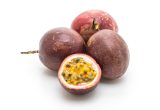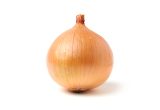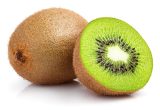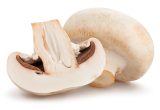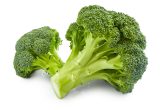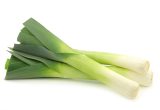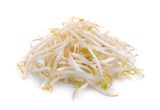Celeriac

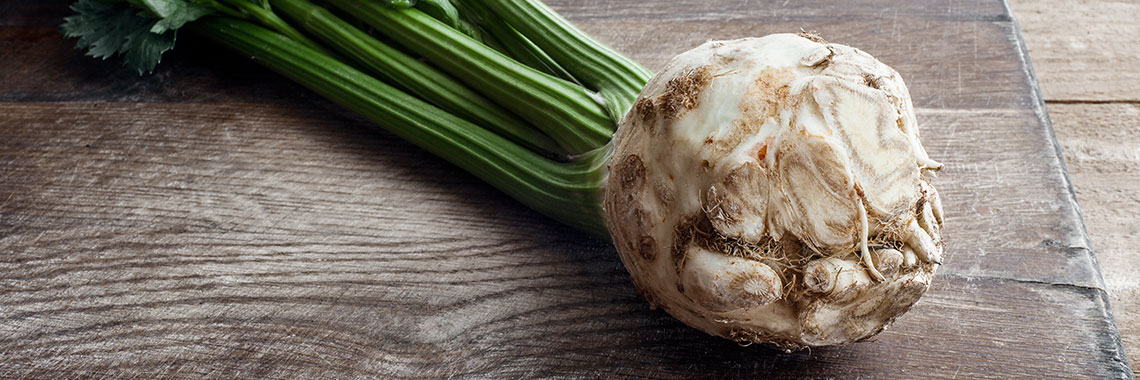
Description
- Celeriac (Apium graveolens var. rapaceum) belongs, like celery, to the Apiaceae family.
- There are different varieties of celeriac, including the Albin and Kompakt cultivars (Schulzova, 2012).
PHYSICAL AND ORGANOLEPTIC CHARACTERISTICS
- The main characteristic of celeriac is the development of a hypocotyl and an enlarged root that form a large, round structure rich in flavour (Bruznican, 2020).
- The petioles are shorter and hollower than those of celery, with a bitter taste and fibrous texture (Bruznican, 2020).
- Both the roots and leaves of celeriac are consumed as a vegetable all over the world. However, it is mainly grown for its roots, which are eaten raw in salads or cooked (Rana, 2017).
- Red pigmentation has also been reported in celeriac cultivars from Eastern Europe, caused by the accumulation of anthocyanins, polyphenols of the flavonoid family (Tan, 2017).
- Celeriac contains 46 volatile compounds. However, it reportedly contains very low levels of caryophyllene and is completely lacking in β-selenin and seven other sesquiterpene hydrocarbons that are essential aromatic components of celery (Bruznican, 2020).
COMPOSITION CHARACTERISTICS (excluding macronutrients, vitamins and minerals)
- Phenolic compounds such as quercetin or luteolin and coumarins present within celery root extracts are reported to exhibit antioxidant and anti-inflammatory effects (Petropoulos, 2018).
- It has been observed that the leaves of celeriac contain 11 times higher amounts of polyphenols than the content present in its root (Kulig, 2019). They give celeriac antioxidant properties (Kooti, 2017).
- Celeriac also contains two natural compounds, apigenin and naringenin, which have been shown to have high inhibitory activity against the protein responsible for the development of chemotherapy resistance in breast cancer (Ghosh, 2020).
RAW
The following values are approximate and depend on variety, season, ripeness, cultivation conditions, etc.
Raw celeriac is low in energy* as it provides an average of 29.30 calories (kcal) per 100 g, i.e. 122 kJ. One celeriac weighs on average 1 kg.
COMPOSITION TABLES
For each nutrient, the tables provide information on the content, minimum and maximum values and the percentage of the Dietary Reference Values (DRVs) for 100 g net of raw celeriac.
*Regulation (EC) No 1924/2006 of the European Parliament and of the Council of 20 December 2006 on nutrition and health claims made on foods.
MACRONUTRIENTS
| Constituent (g) | Average content |
Min-Max per 100g |
DRV% |
|---|---|---|---|
| Water | 88,80 | 86,30 - 90,90 | - |
| Fibers | 4,50 | 1,80 - NC | - |
| Carbohydrates | 3,98 | 3,83 - 4,30 | 1,53 |
| Sugars | 1,60 | NC - 1,79 | 1,78 |
| Lipids | < 0,50 | 0,30 - NC | - |
| Saturated fat | < 0,01 | NC - 0,079 | - |
| Protein | 1,38 | 0,20 - 2,50 | 2,76 |
| Constituent (g) | Amount | Min-Max | DRV% |
|---|---|---|---|
| Water | Ciqual 2020 (valeur issue des analyses Ciqual-Aprifel 2017) | - | - |
| Fibers | Ciqual 2020 (valeur issue des analyses Ciqual-Aprifel 2017) | - | - |
| Carbohydrates | Ciqual 2020 | - | Règlement (UE) N°1169/2011 du parlement Européen et du conseil du 25 octobre 2011 |
| Sugars | Ciqual 2020 (valeur issue des analyses Ciqual-Aprifel 2017) | - | Règlement (UE) N°1169/2011 du parlement Européen et du conseil du 25 octobre 2011 |
| Lipids | Ciqual 2020 (valeur issue des analyses Ciqual-Aprifel 2017) | - | Règlement (UE) N°1169/2011 du parlement Européen et du conseil du 25 octobre 2011 |
| Saturated fat | Ciqual 2020 (valeur issue des analyses Ciqual-Aprifel 2017) | - | Règlement (UE) N°1169/2011 du parlement Européen et du conseil du 25 octobre 2011 |
| Protein | Ciqual 2020 (valeur issue des analyses Ciqual-Aprifel 2017) | - | Règlement (UE) N°1169/2011 du parlement Européen et du conseil du 25 octobre 2011 |
Zoom on carbohydrates
- The carbohydrate content of raw celeriac (3.98 g per 100 g) is lower than the average content found in raw vegetables (4.45 g per 100 g).
- These are mainly polyols, in the form of mannitol (2.20 g per 100 g), and sugars in the form of sucrose (1.60 g per 100 g).
- Raw celeriac is low in sugar* as it contains less than 5 g per 100 g.
Zoom on fibres
- Raw celeriac is a source of fibre* as 100 g provide more than 3 g of fibre, or 4.50 g per 100 g.
- This amount is higher than the average content found in raw vegetables (2.43 g per 100 g).
Zoom on proteins
- The protein content of raw celeriac (1.38 g per 100 g) is lower than the average in raw vegetables (1.87 g per 100 g).
Zoom on lipids
- Raw celeriac is fat-free* as the content is less than 0.5 g per 100 g.
*Regulation (EC) No 1924/2006 of the European Parliament and of the Council of 20 December 2006 on nutrition and health claims made on foods.
MINERALS AND TRACE ELEMENTS
| Constituent | Average content |
Min-Max per 100g |
DRV% |
|---|---|---|---|
| Calcium (mg) | 40 | 23,80 - 56,20 | 5 |
| Chloride (mg) | 104 | - | 13 |
| Copper (mg) | 0,11 | 0,036 - 0,12 | 11 |
| Iron (mg) | 0,28 | 0,22 - 1,40 | 2 |
| Iodine (µg) | < 20 | 0,40 - NC | - |
| Magnesium (mg) | 13 | 10,10 - 20 | 3,47 |
| Manganese (mg) | 0,20 | 0,074 - 0,26 | 10 |
| Phosphorus (mg) | 56 | NC - 115 | 8 |
| Potassium (mg) | 500 | 267 - 559 | 25 |
| Selenium (µg) | < 20 | 0,20 - NC | - |
| Sodium (mg) | 34 | 10,10 - 100 | - |
| Zinc (mg) | 0,33 | 0,15 - 0,73 | 3,30 |
| Constituent | Amount | Min-Max | DRV% |
|---|---|---|---|
| Calcium (mg) | Ciqual 2020 (valeur issue des analyses Ciqual-Aprifel 2017) | - | Règlement (UE) N°1169/2011 du parlement Européen et du conseil du 25 octobre 2011 |
| Chloride (mg) | Ciqual 2020 (valeur issue des analyses Ciqual-Aprifel 2017) | - | Règlement (UE) N°1169/2011 du parlement Européen et du conseil du 25 octobre 2011 |
| Copper (mg) | Ciqual 2020 (valeur issue des analyses Ciqual-Aprifel 2017) | - | Règlement (UE) N°1169/2011 du parlement Européen et du conseil du 25 octobre 2011 |
| Iron (mg) | Ciqual 2020 (valeur issue des analyses Ciqual-Aprifel 2017) | - | Règlement (UE) N°1169/2011 du parlement Européen et du conseil du 25 octobre 2011 |
| Iodine (µg) | Ciqual 2020 (valeur issue des analyses Ciqual-Aprifel 2017) | - | Règlement (UE) N°1169/2011 du parlement Européen et du conseil du 25 octobre 2011 |
| Magnesium (mg) | Ciqual 2020 (valeur issue des analyses Ciqual-Aprifel 2017) | - | Règlement (UE) N°1169/2011 du parlement Européen et du conseil du 25 octobre 2011 |
| Manganese (mg) | Ciqual 2020 (valeur issue des analyses Ciqual-Aprifel 2017) | - | Règlement (UE) N°1169/2011 du parlement Européen et du conseil du 25 octobre 2011 |
| Phosphorus (mg) | Ciqual 2020 (valeur issue des analyses Ciqual-Aprifel 2017) | - | Règlement (UE) N°1169/2011 du parlement Européen et du conseil du 25 octobre 2011 |
| Potassium (mg) | Ciqual 2020 (valeur issue des analyses Ciqual-Aprifel 2017) | - | Règlement (UE) N°1169/2011 du parlement Européen et du conseil du 25 octobre 2011 |
| Selenium (µg) | Ciqual 2020 (valeur issue des analyses Ciqual-Aprifel 2017) | - | Règlement (UE) N°1169/2011 du parlement Européen et du conseil du 25 octobre 2011 |
| Sodium (mg) | Ciqual 2020 (valeur issue des analyses Ciqual-Aprifel 2017) | - | - |
| Zinc (mg) | Ciqual 2020 (valeur issue des analyses Ciqual-Aprifel 2017) | - | Règlement (UE) N°1169/2011 du parlement Européen et du conseil du 25 octobre 2011 |
Zoom on minerals and trace elements
- Raw celeriac is a source of potassium as it provides the equivalent of 25% of DRVs, i.e. 500 mg per 100 g.
- It also contains significant amounts of chloride, copper and manganese. In fact, it provides the equivalent of:
- 13% of DRVs for chloride, i.e. 104 mg per 100 g;
- 11% of DRVs for copper, i.e. 0.11 mg per 100 g;
- 10% of DRVs for manganese, i.e. 0.20 mg per 100 g.
- The other minerals and trace elements are present in quantities representing less than 9% of DRVs.
VITAMINS
| Constituent | Average content |
Min-Max per 100g |
DRV% |
|---|---|---|---|
| Provitamin A Beta-carotene (µg) | < 5 | 0 - NC | - |
| Vitamin A equivalent (µg) | < 0,83 | 0 - NC | - |
| Vitamin B1 (mg) | 0,059 | 0,039 - 0,081 | 5,36 |
| Vitamin B2 (mg) | 0,041 | NC - 0,20 | 2,93 |
| Vitamin B3 (mg) | 0,30 | NC - 1,46 | 1,88 |
| Vitamin B5 (mg) | 0,59 | 0,35 - NC | 9,83 |
| Vitamin B6 (mg) | 0,20 | 0,17 - 0,21 | 14,29 |
| Vitamin B9 (µg) | 39 | 3,60 - NC | 19,50 |
| Vitamin C (mg) | 2,87 | NC - 15 | 3,59 |
| Vitamin E (mg) | 0,12 | 0,10 - 0,92 | 1 |
| Vitamin K1 (µg) | < 0,80 | NC - 100 | - |
| Constituent | Amount | Min-Max | DRV% |
|---|---|---|---|
| Provitamin A Beta-carotene (µg) | Ciqual 2020 (valeur issue des analyses Ciqual-Aprifel 2017) | - | - |
| Vitamin A equivalent (µg) | Calcul à partir de la valeur Provitamine A Béta-carotène* | - | Règlement (UE) N°1169/2011 du parlement Européen et du conseil du 25 octobre 2011 |
| Vitamin B1 (mg) | Ciqual 2020 (valeur issue des analyses Ciqual-Aprifel 2017) | - | Règlement (UE) N°1169/2011 du parlement Européen et du conseil du 25 octobre 2011 |
| Vitamin B2 (mg) | Ciqual 2020 (valeur issue des analyses Ciqual-Aprifel 2017) | - | Règlement (UE) N°1169/2011 du parlement Européen et du conseil du 25 octobre 2011 |
| Vitamin B3 (mg) | Ciqual 2020 (valeur issue des analyses Ciqual-Aprifel 2017) | - | Règlement (UE) N°1169/2011 du parlement Européen et du conseil du 25 octobre 2011 |
| Vitamin B5 (mg) | Ciqual 2020 (valeur issue des analyses Ciqual-Aprifel 2017) | - | Règlement (UE) N°1169/2011 du parlement Européen et du conseil du 25 octobre 2011 |
| Vitamin B6 (mg) | Ciqual 2020 (valeur issue des analyses Ciqual-Aprifel 2017) | - | Règlement (UE) N°1169/2011 du parlement Européen et du conseil du 25 octobre 2011 |
| Vitamin B9 (µg) | Ciqual 2020 (valeur issue des analyses Ciqual-Aprifel 2017) | - | Règlement (UE) N°1169/2011 du parlement Européen et du conseil du 25 octobre 2011 |
| Vitamin C (mg) | Ciqual 2020 (valeur issue des analyses Ciqual-Aprifel 2017) | - | Règlement (UE) N°1169/2011 du parlement Européen et du conseil du 25 octobre 2011 |
| Vitamin E (mg) | Ciqual 2020 (valeur issue des analyses Ciqual-Aprifel 2017) | - | Règlement (UE) N°1169/2011 du parlement Européen et du conseil du 25 octobre 2011 |
| Vitamin K1 (µg) | Ciqual 2020 (valeur issue des analyses Ciqual-Aprifel 2017) | - | Règlement (UE) N°1169/2011 du parlement Européen et du conseil du 25 octobre 2011 |
Zoom on vitamins
- Raw celeriac is a source of vitamin B9 as it represents 19.50% of DRVs, i.e. 39 µg per 100 g.
- It also contains significant amounts of vitamin B6 and vitamin B5. In fact, it provides the equivalent of:
- 14.29% of DRVs for vitamin B6, i.e. 0.20 mg per 100 g;
- 9.83% of DRVs for vitamin B5, i.e. 0.59 mg per 100 g.
- The other vitamins represent less than 6% of DRVs.
*Calculation made: Beta-Carotene / 6 + retinol
POLYPHENOLS
| Constituent (mg) | Average content |
Min-Max per 100mg |
|---|---|---|
| Flavonoids (mg) | 2,59 | 2,59 - 2,59 |
| of which Flavonols (mg) | 0,18 | 0,18 - 0,18 |
| of which Flavones (mg) | 2,41 | 2,41 - 2,41 |
| Lignanes (mg) | 0,02 | 0,01 - 0,03 |
| Total polyphenols | 2,61 | 2,60 - 2,62 |
| Constituent (mg) | Amount | Min-Max |
|---|---|---|
| Flavonoids | Phénol-Explorer version 3.6 Méthode utilisée : chromatographie après hydrolyse | - |
| of which Flavonols | Phénol-Explorer version 3.6 Méthode utilisée : chromatographie après hydrolyse | - |
| of which Flavones | Phénol-Explorer version 3.6 Méthode utilisée : chromatographie après hydrolyse | - |
| Lignanes | Phénol-Explorer version 3.6 Méthode utilisée : chromatographie après hydrolyse | - |
| Total polyphenols | Phénol-Explorer version 3.6 Méthode utilisée : chromatographie après hydrolyse | - |
Zoom on polyphenols
- Polyphenols are substances with an antioxidant effect.
- Raw celeriac contains mainly flavonoids, in the form of flavones according to the chromatographic analysis method after hydrolysis.
BOILED
The following values are approximate and depend on variety, season, ripeness, cultivation conditions, etc.
Boiled celeriac is low in energy* as it provides an average of 26.20 calories (kcal) per 100 g, i.e. 110 kJ. One celeriac weighs on average 1 kg.
COMPOSITION TABLES
For each nutrient, the tables provide information on the content, minimum and maximum values and the percentage of the Dietary Reference Values (DRVs) for 100 g net of celeriac that is boiled/cooked in water.
*Regulation (EC) No 1924/2006 of the European Parliament and of the Council of 20 December 2006 on nutrition and health claims made on foods.
MACRONUTRIENTS
| Constituent (g) | Average content |
Min-Max per 100g |
DRV% |
|---|---|---|---|
| Water | 91 | - | - |
| Fibers | 2,60 | - | - |
| Carbohydrates | 4,32 | - | 1,66 |
| Sugars | 1,20 | - | 1,33 |
| Lipids | 0,30 | - | 0,43 |
| Saturated fat | 0,09 | - | 0,45 |
| Protein | 0,94 | 0,90 - NC | 1,88 |
| Constituent (g) | Amount | Min-Max | DRV% |
|---|---|---|---|
| Water | Ciqual 2020 (valeur issue des analyses Ciqual-Aprifel 2018) | - | - |
| Fibers | Ciqual 2020 (valeur issue des analyses Ciqual-Aprifel 2018) | - | - |
| Carbohydrates | Ciqual 2020 | - | Règlement (UE) N°1169/2011 du parlement Européen et du conseil du 25 octobre 2011 |
| Sugars | Ciqual 2020 (valeur issue des analyses Ciqual-Aprifel 2018) | - | Règlement (UE) N°1169/2011 du parlement Européen et du conseil du 25 octobre 2011 |
| Lipids | Ciqual 2020 (valeur issue des analyses Ciqual-Aprifel 2018) | - | Règlement (UE) N°1169/2011 du parlement Européen et du conseil du 25 octobre 2011 |
| Saturated fat | Ciqual 2020 (valeur issue des analyses Ciqual-Aprifel 2018) | - | Règlement (UE) N°1169/2011 du parlement Européen et du conseil du 25 octobre 2011 |
| Protein | Ciqual 2020 (valeur issue des analyses Ciqual-Aprifel 2018) | - | Règlement (UE) N°1169/2011 du parlement Européen et du conseil du 25 octobre 2011 |
Zoom on carbohydrates
- The carbohydrate content of boiled celeriac (4.32 g per 100 g) is lower than the average carbohydrate content of cooked vegetables (4.85 g per 100 g).
- These are mainly polyols, in the form of mannitol (1.80 g per 100 g), and sugars in the form of sucrose (1.20 g per 100 g).
- Boiled celeriac is low in sugar* as it contains less than 5 g per 100 g.
Zoom on fibres
- The amount of fibre in boiled celeriac (2.60 g per 100 g) is lower than the average amount found in cooked vegetables (2.89 g per 100 g).
Zoom on proteins
- The protein content of boiled celeriac (0.94 g per 100 g) is well below the average for cooked vegetables (2 g per 100 g).
Zoom on lipids
- Boiled celeriac contains 0.30 g of fat per 100 g, which is less than 0.5 g per 100 g. Therefore, the claim “fat-free*” may be used for boiled celeriac.
*Regulation (EC) No 1924/2006 of the European Parliament and of the Council of 20 December 2006 on nutrition and health claims made on foods.
MINERALS AND TRACE ELEMENTS
| Constituent | Average content |
Min-Max per 100g |
DRV% |
|---|---|---|---|
| Calcium (mg) | 41 | - | 5,13 |
| Chloride (mg) | 40,10 | - | 5,01 |
| Copper (mg) | 0,11 | - | 11 |
| Iron (mg) | 0,27 | - | 1,93 |
| Iodine (µg) | < 20 | - | - |
| Magnesium (mg) | 10 | - | 2,67 |
| Manganese (mg) | 0,16 | - | 8 |
| Phosphorus (mg) | 38 | - | 5,43 |
| Potassium (mg) | 300 | - | 15 |
| Selenium (µg) | < 20 | - | - |
| Sodium (mg) | 37 | - | - |
| Zinc (mg) | 0,17 | - | 1,70 |
| Constituent | Amount | Min-Max | DRV% |
|---|---|---|---|
| Calcium (mg) | Ciqual 2020 (valeur issue des analyses Ciqual-Aprifel 2018) | - | Règlement (UE) N°1169/2011 du parlement Européen et du conseil du 25 octobre 2011 |
| Chloride (mg) | Ciqual 2020 (valeur issue des analyses Ciqual-Aprifel 2018) | - | Règlement (UE) N°1169/2011 du parlement Européen et du conseil du 25 octobre 2011 |
| Copper (mg) | Ciqual 2020 (valeur issue des analyses Ciqual-Aprifel 2018) | - | Règlement (UE) N°1169/2011 du parlement Européen et du conseil du 25 octobre 2011 |
| Iron (mg) | Ciqual 2020 (valeur issue des analyses Ciqual-Aprifel 2018) | - | Règlement (UE) N°1169/2011 du parlement Européen et du conseil du 25 octobre 2011 |
| Iodine (µg) | Ciqual 2020 (valeur issue des analyses Ciqual-Aprifel 2018) | - | Règlement (UE) N°1169/2011 du parlement Européen et du conseil du 25 octobre 2011 |
| Magnesium (mg) | Ciqual 2020 (valeur issue des analyses Ciqual-Aprifel 2018) | - | Règlement (UE) N°1169/2011 du parlement Européen et du conseil du 25 octobre 2011 |
| Manganese (mg) | Ciqual 2020 (valeur issue des analyses Ciqual-Aprifel 2018) | - | Règlement (UE) N°1169/2011 du parlement Européen et du conseil du 25 octobre 2011 |
| Phosphorus (mg) | Ciqual 2020 (valeur issue des analyses Ciqual-Aprifel 2018) | - | Règlement (UE) N°1169/2011 du parlement Européen et du conseil du 25 octobre 2011 |
| Potassium (mg) | Ciqual 2020 (valeur issue des analyses Ciqual-Aprifel 2018) | - | Règlement (UE) N°1169/2011 du parlement Européen et du conseil du 25 octobre 2011 |
| Selenium (µg) | Ciqual 2020 (valeur issue des analyses Ciqual-Aprifel 2018) | - | Règlement (UE) N°1169/2011 du parlement Européen et du conseil du 25 octobre 2011 |
| Sodium (mg) | Ciqual 2020 (valeur issue des analyses Ciqual-Aprifel 2018) | - | - |
| Zinc (mg) | Ciqual 2020 (valeur issue des analyses Ciqual-Aprifel 2018) | - | Règlement (UE) N°1169/2011 du parlement Européen et du conseil du 25 octobre 2011 |
Zoom on minerals and trace elements
- Boiled celeriac is a source of potassium as it provides the equivalent of 15% of DRVs, i.e. 300 mg per 100 g.
- It contains a significant amount of copper with a content equivalent to 11% of DRVs, i.e. 0.11 mg per 100 g.
- The other minerals and trace elements are present in quantities representing less than 9% of DRVs for boiled celeriac.
VITAMINS
| Constituent | Average content |
Min-Max per 100g |
DRV% |
|---|---|---|---|
| Provitamin A Beta-carotene (µg) | 7,35 | - | - |
| Vitamin A equivalent (µg) | 1,23 | - | 0,15 |
| Vitamin B1 (mg) | 0,019 | - | 1,73 |
| Vitamin B2 (mg) | 0,02 | - | 1,43 |
| Vitamin B3 (mg) | 0,36 | - | 2,25 |
| Vitamin B5 (mg) | 0,28 | - | 4,67 |
| Vitamin B6 (mg) | 0,074 | - | 5,29 |
| Vitamin B9 (µg) | 84,50 | - | 42,25 |
| Vitamin C (mg) | 0,87 | - | 1,09 |
| Vitamin E (mg) | 1,13 | - | 9,42 |
| Vitamin K1 (µg) | < 0,80 | - | - |
| Constituent | Amount | Min-Max | DRV% |
|---|---|---|---|
| Provitamin A Beta-carotene (µg) | Ciqual 2020 (valeur issue des analyses Ciqual-Aprifel 2018) | - | - |
| Vitamin A equivalent (µg) | Calcul à partir de la valeur Provitamine A Béta-carotène* | - | Règlement (UE) N°1169/2011 du parlement Européen et du conseil du 25 octobre 2011 |
| Vitamin B1 (mg) | Ciqual 2020 (valeur issue des analyses Ciqual-Aprifel 2018) | - | Règlement (UE) N°1169/2011 du parlement Européen et du conseil du 25 octobre 2011 |
| Vitamin B2 (mg) | Ciqual 2020 (valeur issue des analyses Ciqual-Aprifel 2018) | - | Règlement (UE) N°1169/2011 du parlement Européen et du conseil du 25 octobre 2011 |
| Vitamin B3 (mg) | Ciqual 2020 (valeur issue des analyses Ciqual-Aprifel 2018) | - | Règlement (UE) N°1169/2011 du parlement Européen et du conseil du 25 octobre 2011 |
| Vitamin B5 (mg) | Ciqual 2020 (valeur issue des analyses Ciqual-Aprifel 2018) | - | Règlement (UE) N°1169/2011 du parlement Européen et du conseil du 25 octobre 2011 |
| Vitamin B6 (mg) | Ciqual 2020 (valeur issue des analyses Ciqual-Aprifel 2018) | - | Règlement (UE) N°1169/2011 du parlement Européen et du conseil du 25 octobre 2011 |
| Vitamin B9 (µg) | Ciqual 2020 (valeur issue des analyses Ciqual-Aprifel 2018) | - | Règlement (UE) N°1169/2011 du parlement Européen et du conseil du 25 octobre 2011 |
| Vitamin C (mg) | Ciqual 2020 (valeur issue des analyses Ciqual-Aprifel 2018) | - | Règlement (UE) N°1169/2011 du parlement Européen et du conseil du 25 octobre 2011 |
| Vitamin E (mg) | Ciqual 2020 (valeur issue des analyses Ciqual-Aprifel 2018) | - | Règlement (UE) N°1169/2011 du parlement Européen et du conseil du 25 octobre 2011 |
| Vitamin K1 (µg) | Ciqual 2020 (valeur issue des analyses Ciqual-Aprifel 2018) | - | Règlement (UE) N°1169/2011 du parlement Européen et du conseil du 25 octobre 2011 |
Zoom on vitamins
- Boiled celeriac is high in vitamin B9, as it provides 42.25% of DRVs, i.e. 84.50 µg per 100 g.
- It also contains a significant amount of vitamin E with 1.13 mg per 100 g, which represents 9.42% of DRVs.
- The other vitamins represent less than 6% of DRVs.
*Calculation made: Beta-Carotene / 6 + retinol
POLYPHENOLS
Nutrition and health claims
According to the definitions of nutrition claims as set out in Regulation (EC) No 1924/2006 on nutrition and health claims, and in view of the composition of raw celeriac, the following claims may be used:
NUTRITION CLAIMS OF RAW CELERIAC
- Low in energy (100 g of raw celeriac provide less than 40 kcal)
- Fat-free (100 g of raw celeriac contain no more than 0.5 g of fat)
- Low in sugar (100 g of raw celeriac contain no more than 5 g of sugars)
- Source of fibre (100 g of raw celeriac provide over 3 g of fibre)
- Source of potassium (100 g of raw celeriac provide the equivalent of more than 15% of DRVs)
- Source of vitamin B9 (100 g of raw celeriac provide the equivalent of more than 15% of DRVs)
HEALTH CLAIMS (for a consumption of 100 g of raw celeriac)
Potassium
- Potassium contributes to:
- normal functioning of the nervous system,
- normal muscle function,
- maintenance of normal blood pressure.
Folates or vitamin B9
- Folates contribute to:
- maternal tissue growth during pregnancy,
- normal amino acid synthesis,
- normal blood formation,
- normal homocysteine metabolism,
- normal psychological function,
- normal function of the immune system,
- reduction of tiredness and fatigue.
- Folates have a role in the process of cell division.
Nutrition and health claims
According to the definitions of nutrition claims as set out in Regulation (EC) No 1924/2006 on nutrition and health claims, and in view of the composition of boiled celeriac, the following claims may be used:
NUTRITION CLAIMS OF BOILED CELERIAC
- Low in energy (100 g of boiled celeriac provide less than 40 kcal)
- Fat-free (100 g of boiled celeriac contain no more than 0.5 g of fat)
- Low in sugar (100 g of boiled celeriac contain no more than 5 g of sugars)
- High in vitamin B9 (100 g of boiled celeriac provide the equivalent of more than 30% of DRVs)
- Source of potassium (100 g of boiled celeriac provide the equivalent of more than 15% of DRVs)
HEALTH CLAIMS (for a consumption of 100 g of boiled celeriac)
Folates or vitamin B9
- Folates contribute to:
- maternal tissue growth during pregnancy,
- normal amino acid synthesis,
- normal blood formation,
- normal homocysteine metabolism,
- normal psychological function,
- normal function of the immune system,
- reduction of tiredness and fatigue.
- Folates have a role in the process of cell division.
Potassium
- Potassium contributes to:
- normal functioning of the nervous system,
- normal muscle function,
- maintenance of normal blood pressure.
References
- Agence nationale de sécurité sanitaire de l’alimentation, de l’environnement et du travail. Table de composition nutritionnelle des aliments Ciqual 2020. Consultée le 19/08/2020 depuis le site internet Ciqual https://ciqual.anses.fr/
- Bruznican S, De clercq H, Eeckhaut T, Van Huylenbroeck J, Geelen D. Celery and Celeriac: A Critical View on Present and Future Breeding. Front. Plant Sci. 2020;10:1699.
- Ghosh K, Banik A. Anticancer Drug Discovery from Natural Compounds: Identification of Molecular Fingerprints for Inhibition of Breast Cancer Resistance Protein (BCRP) by Monte Carlo Optimization and Machine Learning Approaches. Proceedings of International Conference on Drug Discovery. 2020.
- Kooti W, Daraei N. A Review of the Antioxidant Activity of Celery (Apium graveolens L). Journal of evidence-based complementary & alternative medicine. 2017;22.
- Kulig D, Matysiak M, Baldovská S, Štefániková J, Maruniaková N, Mňahončáková E, Árvay J, Galbavý D, Kolesarova A. Screening of Polyphenolic Compounds from traditional Medicinal Herbs. Journal of microbiology, biotechnology and food sciences. 2019;9(10):487-491.
- Petropoulos SA, Ferreira I, Barros L (2018). Phytochemicals in Vegetables: A Valuable Source of Bioactive Compounds. Bentham Science Publishers , 492 p.
- Neveu V, Perez-Jiménez J, Vos F, Crespy V, du Chaffaut L, Mennen L, Knox C, Eisner R, Cruz J, Wishart D, Scalbert A. (2010) Phenol-Explorer: an online comprehensive database on polyphenol contents in foods. Database, doi: 10.1093/database/bap024. Full text (free access)
- Rana MK, Neha Y (2017). Vegetable Crop Science. Boca Raton : M. K. Rana, 472 p.
- Règlement (CE) N° 1924/2006 du Parlement européen et du Conseil du 20 décembre 2006 concernant les allégations nutritionnelles et de santé portant sur les denrées alimentaires.
- Règlement (UE) N°432/2012 de la Commission du 16 mai 2012 établissant une liste des allégations de santé autorisées portant sur les denrées alimentaires, autres que celles faisant référence à la réduction du risque de maladie ainsi qu’au développement et à la santé infantiles.
- Règlement (UE) n°1169/2011 du Parlement européen et du Conseil du 25 octobre 2011 concernant l’information des consommateurs sur les denrées alimentaires, modifiant les règlements (CE) n°1924/2006 et (CE) n°1925/2006 du Parlement européen et de Conseil et abrogeant la directive 87/250/CEE de la Commission, la directive 90/496/CEE du Conseil, la directive 1999/10/CE de la Commission, la directive 200/13/CE du Parlement européen et du Conseil, les directives 2002/67/CE et 2008/5/CE de la Commission et le règlement (CE) n°608/2004 de la Commission.
- Schulzová V, Babička L, Hajšlová J. Furanocoumarins in celeriac from different farming systems: a 3-year study. J Sci Food Agric. 2012 Nov;92(14):2849-54.
- Tan GF, Ma J, Zhang XY, Xu ZS, Xiong AS. AgFNS overexpression increase apigenin and decrease anthocyanins in petioles of transgenic celery. Plant Sci. 2017;263:31-38.





